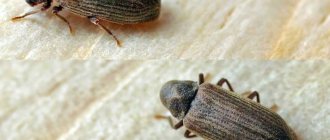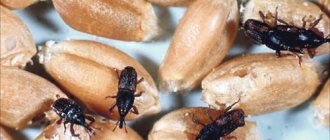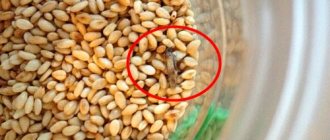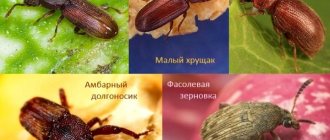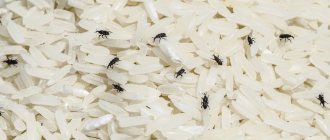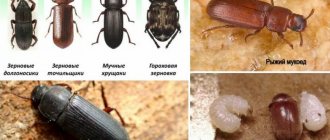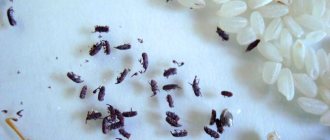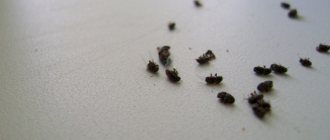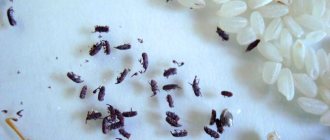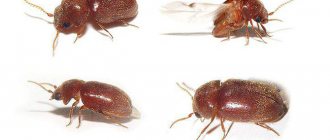The kitchen is the center of attraction of any home. Here they cook, eat, socialize. If unexpectedly bugs from nowhere are discovered in the supply cupboards in the kitchen, housewives get upset.
We have to start fighting small pests, sort through and destroy almost all the products stored on the shelves. These nasty bugs can start in the cleanest kitchen, and you can get rid of them without a trace and quickly enough, before the pest beetles cause significant damage.
Why do bugs appear in the kitchen?
If there are small bugs in the kitchen, you should carefully consider the ways in which they appear in the house.
- Eggs and larvae of insect pests can contaminate unpackaged products purchased in bulk at markets, supermarkets, and wholesale depots where storage conditions are not met.
- Insects can also be found in packages brought from the store, in which low-quality raw materials were packaged from the manufacturer.
- Bugs in the cupboard with cereals can appear from the food products with which they are “neighborhood”. Often the breeding ground for pests are:
- dried fruits;
- loose tea leaves;
- spices and seasonings.
- If the rules for storing groceries at home are not followed:
- increased temperature and humidity;
- unsealed containers;
- excess amount of food purchased for future use.
- Insects can move into grains from wooden furniture or kitchen utensils.
- Come from the neighbors through the ventilation.
From the shop
Ways to enter the house
Small black bugs or their brown counterparts can get into the home in one way - they are brought in with food (usually flour or cereals). Initially, pests infest cereals in production, the reason for this is non-compliance with storage conditions or violation of technical conditions during production. Due to poor quality processing of grain during the production of cereals, it becomes infected.
Bread affected by bread grinders
Bugs also appear in the kitchen if you buy a loose product. They can start under the conditions that were discussed above, however, insects move to clean cereals from a nearby uncovered container with loose product.
When the degree of contamination of food with insects is high, it is better to throw away such cereals and not eat them.
If a bug was found in flour, rice, or millet, it means that pests have already been there and probably multiplied. By consuming such a product, a person risks being poisoned, since insect excrement remains in the contaminated cereal. Such food is not beneficial for another reason - there are practically no nutrients left in it.
Types of bugs
Bugs in the rump may appear as small black dots. Their larvae resemble small, thick white worms. Pests of stocks in our latitudes are most often several types of insects.
- Brown bugs in cereals such as rice, pearl barley, rolled oats are most likely red mucoeds . Their length is less than a grain of rice - 1.5-2 mm. Capable of flying. Adults do not eat flour and cereals, but lay a countless number of eggs, from which very small larvae hatch, not noticeable in the product due to their white color. So they eat the cereal, spoiling it and making it unsuitable for cooking.
- Suriname flour beetle , flour beetle or small beetle is another brownish-brown bug. Its size is slightly more than 3 mm; characteristic numerous teeth can be seen on the sides of the body. White larvae, about 4 mm long, feed on grains damaged by adults. Flour and cereals in the container collect in lumps and acquire an unpleasant musty smell.
On a note! The Suriname flour beetle is one of the most common beetles that pest bulk food products in the world. Colonies of these beetles often occupy granaries and food production facilities, from where they enter the kitchen. Insects are able to live and feed in dried fruits, cookies, leaf tobacco and even plant-based drugs.
- The bread grinder is a bug up to 4 mm long, dark brown in color. The pests are adults and larvae. Adults do not eat cereals directly, but they drill numerous holes in the products themselves and in the packaging. Like all pests, it multiplies quickly at high temperatures. Lives in bakeries and warehouses.
On a note! In English-speaking countries, the pest is called the pharmaceutical beetle, since the insect larvae are not only very voracious, but also indiscriminate in food. They can eat plant and medicinal materials, including poisonous ones. This species can also harm books (especially old ones), entomological collections, raw silk, herbariums, and collection seeds.
- Occasionally in the kitchen you can find a weevil - a tiny round black bug. The length is no more than 1.5 mm. They live mainly in fields where legume crops are cultivated: beans, peas, etc., and take root well in granaries.
Pest danger to humans
The troubles associated with the proximity of a small brown bug for a person are associated with the manifestation of the following negative consequences:
- consequences of a painful bite especially for children and women;
- manifestation of an allergic reaction in people prone to this disease;
- transfer of pathogenic viruses, for example infection by helminths (due to larvae feeding on the remains of plant and animal food);
- deterioration of expensive and beloved things.
Despite its small size, the bite of a brown bug is quite painful. Each person has their own reaction to such bites. It can cause redness and subsequent inflammation at the bite site. During a bite, pathogenic bacteria can enter the wound and cause infection not only of the bite site, but of the entire body.
Therefore, doctors strongly recommend treating with a disinfectant after detection. This could be hydrogen peroxide, iodine or brilliant green.
Let's celebrate! Untimely treatment can cause an inflammatory process, which only a professional physician can help cope with and self-medication will not help.
Are bugs in the kitchen dangerous?
If you find that there are bugs or larvae in cereals, for example, semolina, it is too early to panic, but it is worth collecting information about how pests of stocks can be dangerous:
- If not detected in a timely manner, pests can multiply and move from the original source to other food supplies in the house and damage wooden furniture.
- They will not cause serious poisoning to humans, but they can cause digestive upset.
- Waste products of adults and especially larvae can cause allergy attacks, especially in young children.
What store-bought insect repellents are there?
We have already written what works best and what exactly can be used to get rid of bugs. But, in addition to such means, there are also all sorts of traps, for example, pheromones. You can buy a couple and place them for prevention purposes and to attract those individuals that have survived the main treatment.
Using only traps is unwise and expensive. They do not act as quickly as we would like, judging by the reviews on the Internet. And as long as there are bugs in the kitchen, the cereal will become unusable.
Is it possible to eat contaminated cereals and flour?
Bugs that appear in the kitchen cabinet indicate that the food has been contaminated. Pest control should be started urgently, as they multiply exponentially. Flour, beans, cereals, tea, spices and other groceries are not suitable for human or pet consumption. You need to get rid of them without regret.
Contaminated products
Where do the bugs hide?
Parasites live in secluded places in the kitchen, and not only in grain crops. Preparing a folk remedy for poisoning is not the wisest decision. This is due to the persistence of parasites in the most unexpected places. Here are some examples:
- spices and medicines. Favorite medium: mustard plasters, pepper, seasoning, various herbs. Carefully inspect the drawers and boxes where spices are stored. Check the packages of patches, tablets;
- coffee beans, loose leaf tea, dried fruits. Mucoeds and rice weevils are not visible in a filled dark container due to their camouflage color;
- boxes with vegetables. Living creatures prefer to spoil and feast on the bulbs. Vegetables become soft and smell unpleasant. Go through the box or grid. If you find a creeping buildup, discard immediately;
- walls of kitchen cabinets, cracks, window sills, floors. The light is not pleasant to the winged ones, so they hide in secluded places;
- Appliances. Small creatures nest in mixers and meat grinders, where food particles remain.
Beans remain the perfect home for unpleasant inhabitants. By gnawing holes in beans, they lay eggs there. The beans become covered with dark spots and holes. Throw away such beans without regret.
Expert opinion
Tatiana Leontyeva
Professional housewife
I recommend storing your homegrown beans in the refrigerator. Agree that it is unpleasant to cook a dish from beans that have previously been attacked. But they must be consumed quickly after this.
Methods for getting rid of bugs in the kitchen
Don’t despair if you find pests in food supplies. There are several ways to get rid of bugs in your kitchen cabinets.
First you need to empty your cabinets and closets. Next, check the furniture and shelves for eggs and insect larvae and destroy them.
Folk methods of struggle
You can get rid of bugs that have infested cereals in the kitchen using old, proven methods. Our grandmothers also knew how to get rid of flour bugs in the cupboard quickly and safely.
- The first way to remove bugs from cereals is to place small containers with vegetable oil in the corners of kitchen cabinets. Pests attracted by the smell fall into the oil, which clogs the spiracles (holes through which insects breathe). After some time, the insects die.
- The next thing you can do if there are bugs in the cereal is to place plants with a repulsive odor in the cabinets. Natural repellents are: bay leaf;
- lavender;
- pyrethrum (chamomile);
- sagebrush.
Attention! Remember that sodium tetraborate is poisonous. Do not use poisoned baits where children or pets can reach them.
Chemicals
In stores you can purchase ready-made poisonous compounds that will allow you to fight bugs and get rid of unwanted bugs in your closet forever.
The following drugs are intended to combat them:
- "Antizhuk" is an insecticide for surface treatment.
- “Rogneda” will allow you to get rid of not only cereal bugs, but also cockroaches.
- “Dichlorvos” is an aerosol that allows you to treat crevices and cracks in furniture that can harbor pests.
Dichlorvos
Attention! When using insecticides, take precautions:
- all food must be removed from the kitchen;
- hands, eyes and respiratory organs must be protected with PPE;
- carry out processing without children and pets.
You can treat the cabinet with a chlorine solution, for example, “Belizna”, and the more saturated the solution, the more effective the expected result. After this, it is necessary to ventilate the room.
The famous bread borer parasite
- Many housewives have often encountered the famous insect - the bread borer. The bug is brown in appearance, flies, eats all types of foods:
- Settles on vegetables and fruits;
- Lives well in rice, buckwheat, wheat, oats, happily attacks beans, semolina, and oatmeal;
- You can often notice the pest on baked goods; they like to eat black and white bread, crackers, and loaves;
- Settles on pasta, noodles, vermicelli, spaghetti;
- It multiplies well and quickly in flour;
- If there is cat or dog food, bugs are sure to settle there;
- An uninvited pet will also visit the trash can, it will use it for reproduction;
- If there is an accumulation of water in the sink, it will serve as a real swimming pool for the parasite;
- The insect feeds on spices; coriander is suitable for it, as a seasoning for soups, as well as meat dishes;
- The bug will settle on all kitchen items, it will appear on crusts of bread, in dirty dishes, on unwashed rags, in pans with leftover food, if the oil is not covered, and the pest will also appear there;
- The insect, without hesitation, appears on confectionery products: bagels, sugar, pancakes, donuts, jam;
- The insolent bug eats dried flowers, seeds, dried plants, tubers and bulbs.
For comrades, the bacterial feast is great for reproduction. When preparing bread kvass, pests often appear; for them, like for others, there are no obstacles to reproduction. Larvae can be found on food products.
Prevention of bugs
Kitchen bugs will not appear in the kitchen if you follow the rules for purchasing, storing and processing food.
- Buy cereals, flour, grain products, beans, dried fruits, and vegetable raw materials in transparent containers. This will help you take a closer look at the contents of the package. Also make sure that the package is intact.
- Purchased goods can be disinfected at home:
- holding it in direct sunlight (ultraviolet);
- calcined in the oven at a temperature of about +1000C (not suitable for all products);
- low temperatures have a detrimental effect on pests, especially in the egg and larval stages, so it is worth placing them in the freezer for a day.
- Inventory in cupboards and pantries should be checked periodically to identify pests. Particular attention should be paid to products brought from the market: dried fruits, spices, etc.
- Storage containers should be pre-washed with soda solution.
- Shelves and cabinet walls can be treated with a vinegar solution or disinfectant.
- You should not allow an excess of groceries; do not buy for future use.
- It is better to pour store-bought cereals and flour into clean, sealed containers made of glass or plastic.
- It is necessary to maintain optimal temperature and humidity conditions in the kitchen and utility rooms.
- Try not to purchase products that have not passed phytosanitary control.
